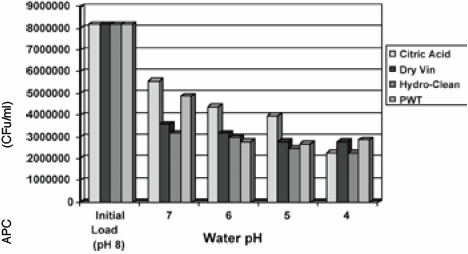



Impact of Water Acidifiers on Microbial Loads in Poultry Drinking Water
By Miranda Bowen and Susan Watkins and published by the University of Arkansas's Avian Advice - A broiler producer called with a complaint about flock performance. He explained that he used iodine for 2-3 days and then would switch the birds to an acidifier.| The Author | |
 Dr. Susan Watkins Extension Poultry Specialist |
|
Case Study
While the birds were on the iodine, the droppings remained firm. Once the birds were switched to the acidifier, the bird droppings became loose. The producer was advised to keep the birds on either iodine or household bleach (used at a rate of 4 ounces/gallon stock solution then 1 ounce of stock to a gallon of water) and skip the acidifier. Bird performance improved. While the obvious response was to keep the
birds on the iodine, it was puzzling that the commonly used acidifier had this impact. Yet, acidifier products typically have one size fits all preparation and mixing directions that do not take into consideration the natural buffering capacity of the water being treated. In fact, since bacteria can become resistant to acid treatments, this one size fits all approach to water treatment could enhance bacterial growth rather than limit it. We therefore conducted a little experiment to determine how acidifiers might be impacting bacterial growth in the water.
Purpose: To test the effect of different chemicals used to adjust water pH on the survival of bacteria.
Materials & Methods
Water with a pH greater than 8 was obtained from a local farm. This water was blended with dirty water from a breeder plasson and then incubated for 72 hours at 86°F (30°C). After determining initial aerobic bacterial count (control) and pH, the water was divided into 50 ml portions. The following treatments were used to adjust dirty water samples to pHs of 7, 6, 5 and 4: Citric Acid, Dry Vin, Hydro-Clean, and Poultry Water Treatment (PWT). One 50 ml portion was used for each pH level and treatment tested. Table 1 contains data describing the preparation and characteristics of the products tested.

Each portion of pH adjusted dirty water sat for 5 minutes before plating to determine aerobic bacterial count (APC). APC was reported in colony forming units per ml (CFU/ml).

Results and Conclusion
The data in Figure 1 illustrate the fact that none of the treatments reduced the initial bacterial count of 8.2 million to below one million CFU/ml. Thus, the selected treatments had essentially no effect on the growth of the bacteria at pHs of 7, 6, 5 and 4. These data suggest that adjusting the pH down to the range of 4 and 5 was not enough to reduce aerobic plate count populations in water which already had a heavy microbial load. Although additional experiments are necessary to draw final conclusions, these results suggest that in heavily contaminated systems the use of acidifiers alone may not be enough to improve water quality. This confirms that water acidifiers should be used in conjunction with water sanitizers such as chlorine, iodine or chorine dioxide.

Figure 1. Aerobic Plate Counts (APC) from Treated Water
Source: Avian Advice - Fall 2005 - Volume 7, Number 3









